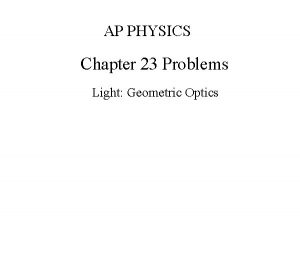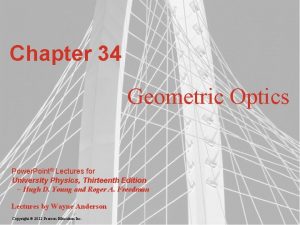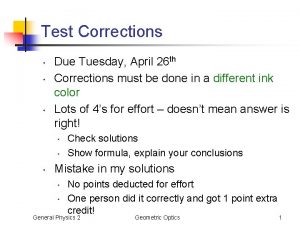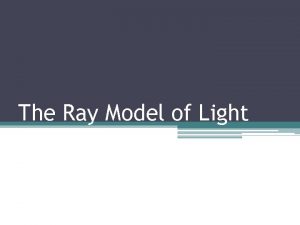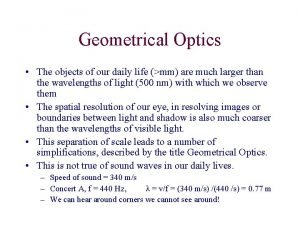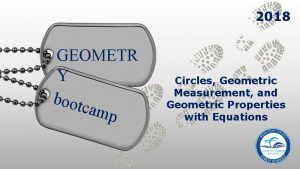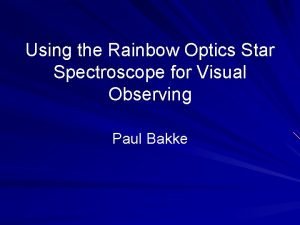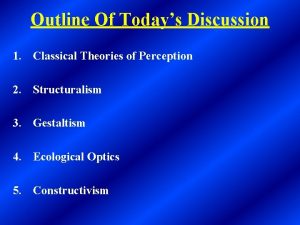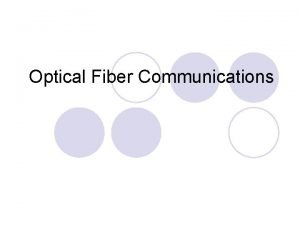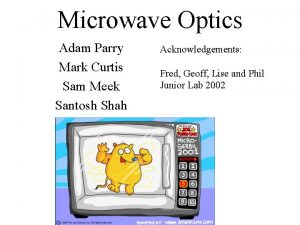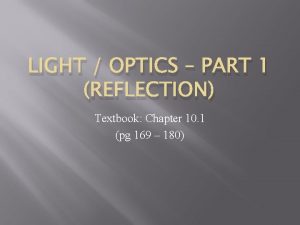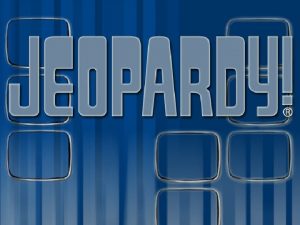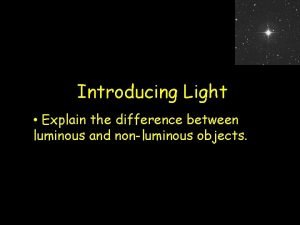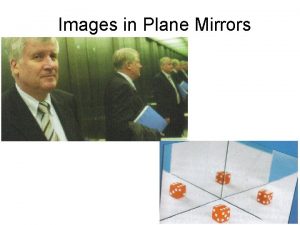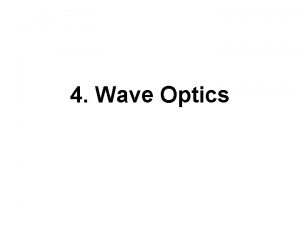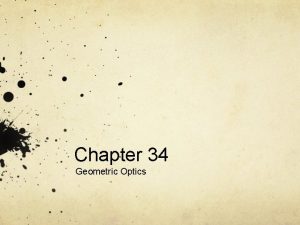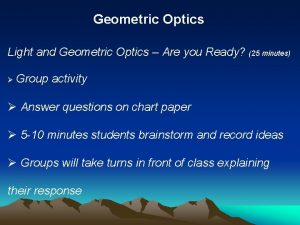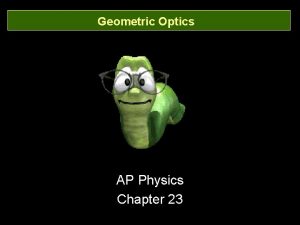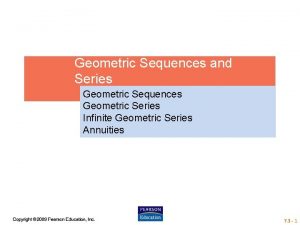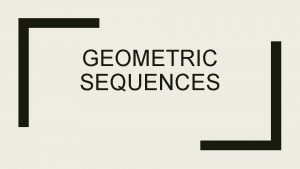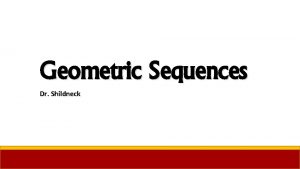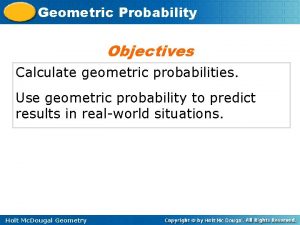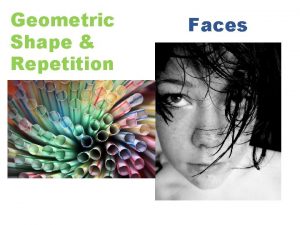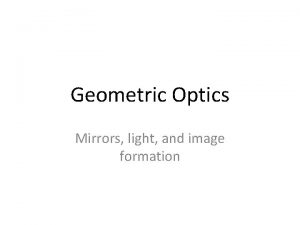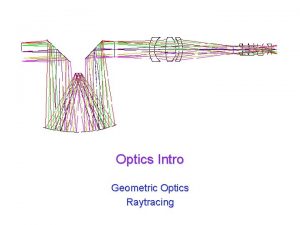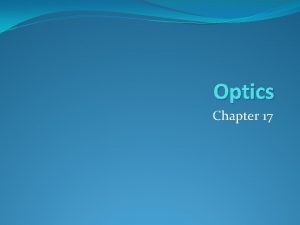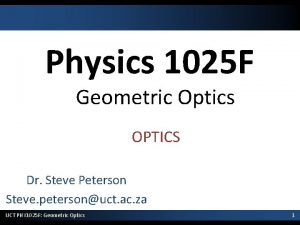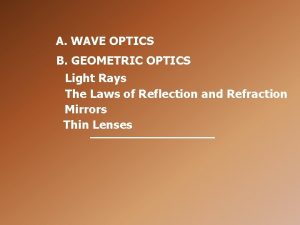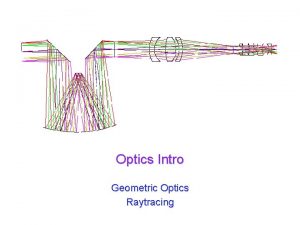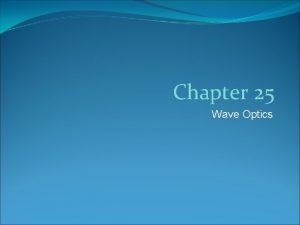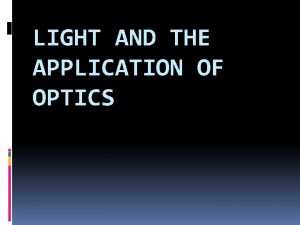Geometric Optics Geometric Optics The process of using


































































- Slides: 66

Geometric Optics �Geometric Optics: The process of using light rays to determine how light behaves when it strikes an object. �Light travels in a STRAIGHT LINE

ANOTHER WAY TO THINK OF LIGHT �Light leaving the candle travels in all directions, but we only SEE the light that travels in to our Eye-Brain

ANOTHER WAY TO THINK OF LIGHT (CONT’D) �We don’t see light that doesn’t enter our eyes.

ANOTHER WAY TO THINK OF LIGHT (CONT’D) �If the light going away from eyes is reflected in to our Eye-Brain, then we will see it.

SIDE NOTE �When we look at diagrams, we will ignore light that doesn’t enter our Eye. Brain. �Don’t forget that the other light exists, we are just ignoring it to simplify our lives!

RAYS & DIAGRAMS �Ray Diagrams show light moves from the object to the eye. �Light Ray – a line on a diagram representing the direction and path that light is travelling.

LUMINOUS SOURCES �Atoms in LUMINOUS OBJECTS emit light rays in all directions produced from other energy sources. �Atoms in NON-LUMINOUS OBJECTS scatter the light rays from luminous objects in all directions.

NOTE �Atoms in all objects produce or scatter light rays. This diagram only shows light rays from atoms at the top and bottom of the objects.

KEEP IT SIMPLE � To make diagrams simpler, we only show one ray of light from the top and bottom of objects. � We simplify it even more and just show only the rays coming from the top of the object.

MEDIUMS � A TRANSPARENT MEDIUM allows nearly all rays to pass straight through unaltered. (Ex. Air) � An OPAQUE MEDIUM absorbs or scatters all the rays. (Ex. Textbook, wall, etc. )

MEDIUMS (CONT’D) �A TRANSLUCENT MEDIUM transmits and scatters the rays. Wax paper causes light rays to bounce off and scatter, so you can see light coming through but no clear image.

The Laws of Reflection

Images in Plane Mirrors

a mirror. a piece of shiny metal wall. a piece of window glass. calm water surface.

�A mirror is any polished surface that allows an image to be produced through reflection. An image is a reproduction of the original object in front of the mirror that is produced through the use of light.

Normal Reflected ray Incident ray Angle of incidence Angle of reflection Mirror

Properties of Light that Lead to Reflection �Light reflects off of ALL surfaces �A beam of light can be thought of as a group of individual rays of light all travelling together

Laws of Reflection Investigation Page 482

The Two Laws of Reflection

LAW #1 Angle of incidence = Angle of reflection In other words, light gets reflected from a surface at the same angle it hits it. normal incident ray mirror reflected ray

LAW #2 The incident ray, the reflected ray, and the normal all lie in the same plane.

Question 1 The angle between an incident ray and the mirror is 20. The angles of incidence and reflection are ____ and ____. 20

Question 1 The angle between an incident ray and the mirror is 20. 70 and ____. 70 The angles of incidence and reflection are ____ 20

P. O. E Predict! Will there be a difference if I shine light off of a smooth piece of aluminum foil compared to if I shine light off a crumpled piece of aluminum foil? VS

P. O. E Observe!

P. O. E Explain! This can be explained with the terms specular reflection and diffuse reflection!

Specular Reflection • Light reflects off a smooth, shiny surface • Examples: plane mirror, still water, smooth piece of aluminum foil parallel incident rays • Produces a clear reflection parallel reflected rays

Diffuse Reflection • Light reflects off a rough, not perfectly smooth surface • Examples: cover of a book, waves, a crumpled piece of aluminum foil parallel incident rays • Produces a diffuse (unclear) reflection reflected rays in different directions

True or False? �Reflection of light by a rough surface does not obey the 2 laws of reflection. l. Does the angle of incidence = angle of reflection? l. Does the incident ray, normal, and reflected ray lie in the same plane?

True or False? �Reflection of light by a rough surface does not obey the 2 laws of reflection. l. Does the angle of incidence = angle of reflection? l. Does the incident ray, normal, and reflected ray lie in the same plane?

Even in diffuse reflections, each incident ray is reflected back at the same angle it strikes the object! Angle of incidence = Angle of reflection Additional example: Textbook page 485 Figure 5

Specular Reflection �A specular reflection is reflection off a smooth surface �The light bounces off in a predictable and consistent way

Specular Reflection �A specular reflection is reflection off a smooth surface �The light bounces off in a predictable and consistent way

Diffuse Reflection �A diffuse reflection occurs off a surface that is not smooth �Light rays are scattered and reflect in many different directions �Even microscopically rough surfaces will produce this effect

Diffuse Reflection �A diffuse reflection occurs off a surface that is not smooth �Light rays are scattered and reflect in many different directions �Even microscopically rough surfaces will produce this effect


Types of Mirrors Plane Mirrors Parabolic (curved) Mirrors

Properties of Plane Mirrors �The image is right-side-up (not inverted) �Left and right are reversed �The image is the same size as the object (unmagnified) �Light reflects with the properties of angles discovered earlier this class

Challenge Question: Which of these appears on the front of an ambulance?

The writing on an ambulance is reversed because… The image in a plane mirror is reversed Therefore, this is what we see when we look in the rearview mirror

More examples…

Question �What letters of the alphabet will appear the same in a plane mirror? ABCDEFGHIJKLMNOP QRSTUVWXYZ

Question �What letters of the alphabet will appear the same in a plane mirror? ABCDEFGHIJKLMNOP QRSTUVWXYZ

Using Light Rays to Locate an Image �We know that light travels in straight lines! �Our brain doesn’t understand that light reflects �When our eyes detect reflected light from a plane mirror, we project these rays backwards in a straight line

Source and Apparent Source Light Source Apparent Light Source Virtual rays are shown using dotted lines

Using Equal Perpendicular Lines to Locate an Image 3 cm 2. 7 cm 3 cm Two Helpful Hints: 2. 7 cm 1. The distance from the object to the mirror is the same as the distance from the image to If the tip of the pencil is 3 cm the mirror away from the mirror, the reflection of image will also be 3 cm away

Using Equal Perpendicular Lines to Locate an Image Two Helpful Hints: 2. The object-image line is perpendicular to the mirror surface

Diagram The Ray Diagram shows that: • ON = IN • OI ⊥NM N O M I

Locating Images So how do we draw ray diagrams?

Drawing the virtual image �Step One: ◦ Choose several points on the object and draw a perpendicular line to the mirror

Drawing the virtual image �Step Two ◦ Measure the distance of this line 1 cm 1. 5 cm 2 cm

Drawing the virtual image �Step Three ◦ Extend this line an equal distance behind the mirror 1 cm 1. 5 cm 2 cm

Drawing the virtual image �Step Four ◦ Repeat these steps until you have enough lines to accurately locate your image 1 cm 1. 5 cm 2 cm Virtual image = an image in which light does not actually arrive at

Drawing the virtual image �Step Five ◦ Draw in the reflected ray 1 cm 1. 5 cm 2 cm Virtual image = an image in which light does not actually arrive at

Drawing the virtual image �Step Five ◦ Draw in the incident ray 1 cm 1. 5 cm 2 cm Virtual image = an image in which light does not actually arrive at

Practice Question 1 Mirror

Practice Question 1 Mirror

Practice Question 2 Mirror

Practice Question 2 Mirror

Going back to the beginning…

Four Characteristics of an Image But…. How are we suppose to remember this? SAL T

S stands for SIZE �What is the size of the object? �Larger, Smaller, or the Same Size as the object? LARGER SAME SMALLER

A stands for ATTITUDE �How is the image oriented? �Is the image upright or inverted? UPRIGHT INVERTED

L stands for LOCATION �Is the image in front or behind the mirror? �Is the length from the object to mirror the same as the image to mirror? ?

T stands for TYPE �Is the image real or virtual? • A real image is formed when light is actually arriving at the image location • A virtual image is formed from an apparent light source VIRTUAL REAL

Question: What is the SALT for plane mirrors? Same Size Upright Behind the Mirror (the same distance behind) Virtual
 Reflection and refraction venn diagram
Reflection and refraction venn diagram Difference between ray optics and wave optics
Difference between ray optics and wave optics Optics
Optics Geometric optics ppt
Geometric optics ppt Geometric optics
Geometric optics What has historically been the main use for plane mirrors?
What has historically been the main use for plane mirrors? Geometric optics in real life
Geometric optics in real life Geometry bootcamp answers
Geometry bootcamp answers Hình ảnh bộ gõ cơ thể búng tay
Hình ảnh bộ gõ cơ thể búng tay Bổ thể
Bổ thể Tỉ lệ cơ thể trẻ em
Tỉ lệ cơ thể trẻ em Gấu đi như thế nào
Gấu đi như thế nào Tư thế worm breton là gì
Tư thế worm breton là gì Alleluia hat len nguoi oi
Alleluia hat len nguoi oi Kể tên các môn thể thao
Kể tên các môn thể thao Thế nào là hệ số cao nhất
Thế nào là hệ số cao nhất Các châu lục và đại dương trên thế giới
Các châu lục và đại dương trên thế giới Công thức tính thế năng
Công thức tính thế năng Trời xanh đây là của chúng ta thể thơ
Trời xanh đây là của chúng ta thể thơ Mật thư tọa độ 5x5
Mật thư tọa độ 5x5 Làm thế nào để 102-1=99
Làm thế nào để 102-1=99 độ dài liên kết
độ dài liên kết Các châu lục và đại dương trên thế giới
Các châu lục và đại dương trên thế giới Thơ thất ngôn tứ tuyệt đường luật
Thơ thất ngôn tứ tuyệt đường luật Quá trình desamine hóa có thể tạo ra
Quá trình desamine hóa có thể tạo ra Một số thể thơ truyền thống
Một số thể thơ truyền thống Bàn tay mà dây bẩn
Bàn tay mà dây bẩn Vẽ hình chiếu vuông góc của vật thể sau
Vẽ hình chiếu vuông góc của vật thể sau Nguyên nhân của sự mỏi cơ sinh 8
Nguyên nhân của sự mỏi cơ sinh 8 đặc điểm cơ thể của người tối cổ
đặc điểm cơ thể của người tối cổ Thế nào là giọng cùng tên
Thế nào là giọng cùng tên Vẽ hình chiếu đứng bằng cạnh của vật thể
Vẽ hình chiếu đứng bằng cạnh của vật thể Vẽ hình chiếu vuông góc của vật thể sau
Vẽ hình chiếu vuông góc của vật thể sau Thẻ vin
Thẻ vin đại từ thay thế
đại từ thay thế điện thế nghỉ
điện thế nghỉ Tư thế ngồi viết
Tư thế ngồi viết Diễn thế sinh thái là
Diễn thế sinh thái là Dạng đột biến một nhiễm là
Dạng đột biến một nhiễm là Các số nguyên tố là gì
Các số nguyên tố là gì Tư thế ngồi viết
Tư thế ngồi viết Lời thề hippocrates
Lời thề hippocrates Thiếu nhi thế giới liên hoan
Thiếu nhi thế giới liên hoan ưu thế lai là gì
ưu thế lai là gì Hổ sinh sản vào mùa nào
Hổ sinh sản vào mùa nào Khi nào hổ mẹ dạy hổ con săn mồi
Khi nào hổ mẹ dạy hổ con săn mồi Hệ hô hấp
Hệ hô hấp Từ ngữ thể hiện lòng nhân hậu
Từ ngữ thể hiện lòng nhân hậu Thế nào là mạng điện lắp đặt kiểu nổi
Thế nào là mạng điện lắp đặt kiểu nổi Using system.collections.generic
Using system.collections.generic Unit 25 special refrigeration system components
Unit 25 special refrigeration system components Rainbow optics star spectroscope
Rainbow optics star spectroscope Gestaltism
Gestaltism Turba optics
Turba optics Optical power loss
Optical power loss Microwave optics
Microwave optics Single ray
Single ray Grade 10 optics
Grade 10 optics Physics 241 purdue
Physics 241 purdue Difference between luminous and non luminous objects
Difference between luminous and non luminous objects Salt optics acronym
Salt optics acronym Hotwire fiber optics
Hotwire fiber optics Single slit envelope
Single slit envelope Wave optics topics
Wave optics topics With the rule astigmatism axis
With the rule astigmatism axis Fourier optics
Fourier optics


